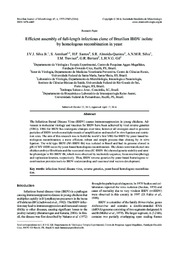Efficient assembly of full-length infectious clone of Brazilian IBDV isolate by homologous recombination in yeast.
Efficient assembly of full-length infectious clone of Brazilian IBDV isolate by homologous recombination in yeast.
Author(s): SILVA JÚNIOR, J. V. J.; ARENHART, S.; SANTOS, H. F. dos; ALMEIDA-QUEIROZ, S. R.; SILVA, A. N. M. R.; TREVISOL, I. M.; BERTANI, G. R.; GIL, L. H. V. G.
Summary: The Infectious Bursal Disease Virus (IBDV) causes immunosuppression in young chickens. Advances in molecular virology and vaccines for IBDV have been achieved by viral reverse genetics (VRG). VRG for IBDV has undergone changes over time, however all strategies used to generate particles of IBDV involves multiple rounds of amplification and need of in vitro ligation and restriction sites. The aim of this research was to build the world?s first VRG for IBDV by yeast-based homologous recombination; a more efficient, robust and simple process than cloning by in vitro ligation. The wild type IBDV (Wt-IBDV-Br) was isolated in Brazil and had its genome cloned in pJG-CMV-HDR vector by yeast-based homologous recombination. The clones were transfected into chicken embryo fibroblasts and the recovered virus (IC-IBDV-Br) showed genetic stability and similar phenotype to Wt-IBDV-Br, which were observed by nucleotide sequence, focus size/morphology and replication kinetics, respectively. Thus, IBDV reverse genetics by yeast-based homologous recombination provides tools to IBDV understanding and vaccines/viral vectors development.
Publication year: 2014
Types of publication: Journal article
Unit: Embrapa Swine & Poultry
Observation
Some of Embrapa's publications are published as ePub files. To read them, use or download one of the following free software options to your computer or mobile device. Android: Google Play Books; IOS: iBooks; Windows and Linux: Calibre.
Access other publications
Access the Agricultural Research Database (BDPA) to consult Embrapa's full library collection and records.
Visit Embrapa Bookstore to purchase books and other publications sold by Embrapa.

